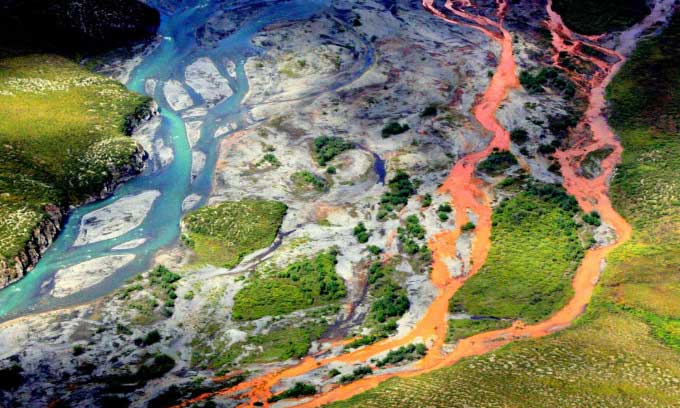The culprit caused a series of Alaska rivers and streams to turn orange
Warmer climate causes permafrost to melt, releasing the metal ores inside into rivers and streams, causing them to turn rusty.
A group of scientists from the US National Park Service (NPS), the US Geological Survey (USGS), the University of California Davis (UC Davis) and a number of other organizations announced new findings about the currents. Alaska's "rusty" rivers and streams after nearly two years of sampling and study. These findings were published in the journal Nature Communications Earth & Environment on May 20.

The rust-colored Kutuk River in Arctic Gates National Park, Alaska, seen from above. (Photo: Ken Hill/National Park Service).
NPS ecologist Jon O'Donnell, the study's lead author, first saw the strange phenomenon in Alaska in 2018. The river he observed turned orange even though it was clear a year ago. The number of rivers and streams changing color is increasing, and can now even be observed from space.
Late last year, the scientific community suggested that permafrost melting was most likely the culprit. With the warming climate, this situation in Alaska is happening faster. Metal ores trapped in ice for hundreds to thousands of years will react when exposed to oxygen and water, releasing acids and metals directly into nearby rivers and streams. While rivers and streams can naturally clean themselves and permafrost can freeze, climate change is making this process more difficult.
Brett Poulin, associate professor of environmental toxicology at UC Davis, and researcher Taylor Evinger analyzed the collected samples and discovered that the orange rivers became increasingly acidic due to the mineral mixture flowing into them. Some samples had a pH of 2.3, while "healthy" rivers and streams in the region had an average pH of 8.
Researchers found that weathering of sulfide minerals is creating an acidic and corrosive environment , causing more metals to be released. As a result, they obtained samples with high levels of iron, zinc, nickel, copper and cadmium. " One of the most common metals is iron. That's what causes the discoloration ," Evinger says.
"As the climate continues to warm, we predict permafrost will continue to melt. Therefore, wherever these minerals are present, rivers and streams are likely to turn orange and degraded water quality. These orange streams can cause many problems, not only being toxic but also hindering fish from migrating to breeding grounds ," O'Donnell said.
The team of scientists is still uncertain about the impact of orange rivers and streams on the wildlife that depends on them as well as on the rural Alaskan communities that come for drinking water and to fish. They hope to understand this by the end of this three-year study.
- Anomalies orange causes Alaskan tumors
- The piece of orange orange turned purple after only one night, the scientific community did not understand why
- Big flood isolated many areas in Lao Cai, 11 people died and went missing
- Why is the turn signal light orange?
- Turn orange peel into fuel and antimicrobial agent
- The 'magic' images of winter in Alaska
- Rivers are infected with antibiotics
- A record snowfall makes the river water level in the Great Plains rise
- Confluent rivers are not suitable for color matching
- Air pollution increases river flow
- 12 effects of orange juice are best for health
- Extraordinary orange snow in Russia
 Is the magnetic North Pole shift dangerous to humanity?
Is the magnetic North Pole shift dangerous to humanity? Washington legalizes the recycling of human bodies into fertilizer
Washington legalizes the recycling of human bodies into fertilizer Lightning stone - the mysterious guest
Lightning stone - the mysterious guest Stunned by the mysterious sunset, strange appearance
Stunned by the mysterious sunset, strange appearance